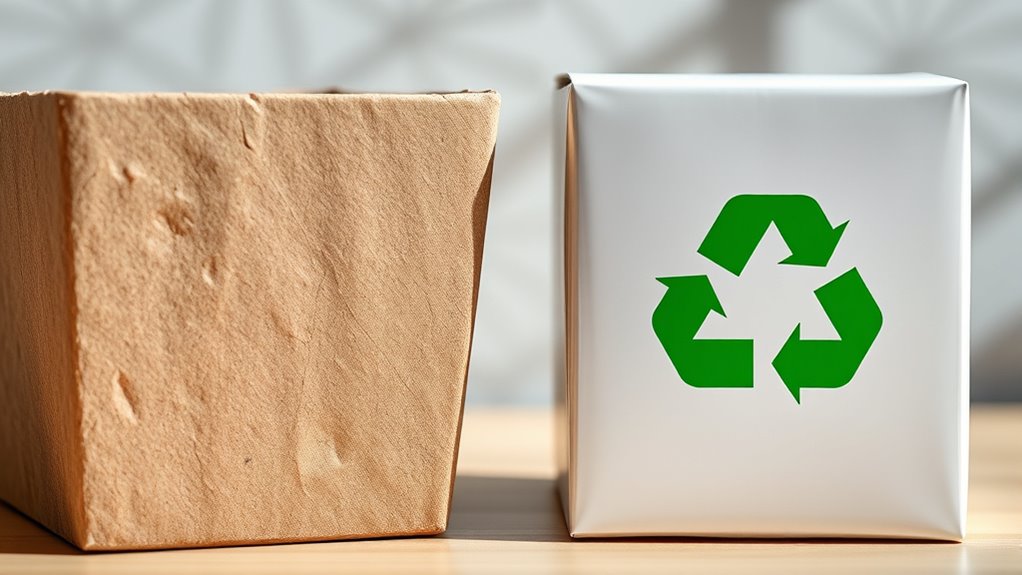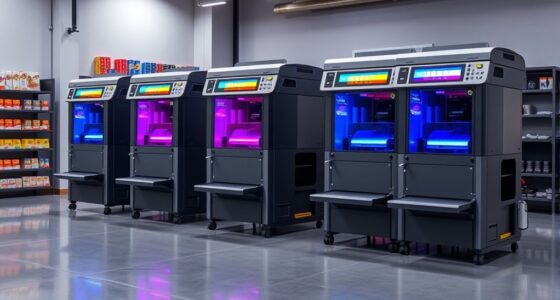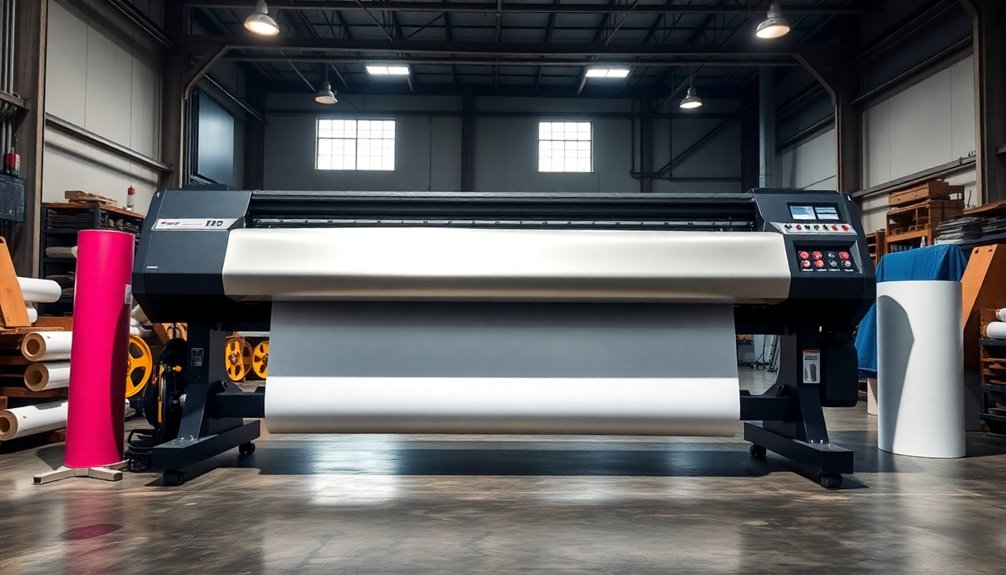Biodegradable packaging breaks down naturally through microorganisms, returning to the earth in months, especially when composted properly. Recyclable packaging, on the other hand, can be processed and reused multiple times but may take years if not properly recycled. Both options reduce waste and environmental impact, but their effectiveness depends on disposal practices and material types. Understanding these differences helps you make smarter choices—there’s much more to discover if you keep going.
Key Takeaways
- Biodegradable packaging naturally decomposes into harmless components within months via microorganisms, reducing environmental impact.
- Recyclable packaging can be processed into new products multiple times, conserving resources and supporting a circular economy.
- Biodegradable materials often require composting conditions, while recyclables need proper sorting and recycling infrastructure.
- Biodegradable packaging typically has a shorter decomposition time but may be limited in reuse potential; recyclables can be reused repeatedly.
- The environmental benefits depend on disposal practices, material properties, and local waste management systems.
Understanding Biodegradable Materials

Biodegradable materials are substances that can break down naturally into harmless components through the action of microorganisms such as bacteria and fungi. These materials often include biodegradable polymers, which are specially designed plastics that decompose more quickly than traditional plastics. To facilitate this process, composting methods are employed, turning waste into nutrient-rich soil. Composting methods vary from industrial facilities to home setups, but the goal remains the same: accelerate the breakdown of biodegradable materials. When these materials are properly composted, they return to the earth without leaving harmful residues. By understanding biodegradable materials and their composting options, you can make more environmentally conscious choices that minimize pollution and support sustainable waste management practices.
The Recycling Process and Its Benefits

Recycling transforms used materials into new products, conserving resources and reducing waste sent to landfills. With effective recycling infrastructure, you can easily sort and dispose of items properly, ensuring they re-enter the production cycle. Your participation is essential; the more you recycle correctly, the more efficient the process becomes. Recycling offers numerous benefits, including saving energy, lowering greenhouse gas emissions, and reducing the demand for raw materials. When you understand how recycling works, you help support a sustainable environment. Key aspects include proper sorting, avoiding contamination, and following local recycling guidelines. By actively engaging in recycling efforts, you contribute to a circular economy that minimizes waste and maximizes resource reuse. Color accuracy in recycling symbols and labels can improve the sorting process and reduce contamination, making recycling efforts more effective. Your choices directly impact the success of recycling programs and environmental health.
Environmental Impact and Decomposition Time

While both biodegradable and recyclable packaging aim to reduce environmental harm, their impacts differ substantially when it comes to decomposition time. Biodegradable packaging breaks down quickly through natural processes, often within months, especially when proper composting methods are used. This helps prevent marine debris, which can otherwise persist for years and harm aquatic life. Recyclable materials, on the other hand, require collection, processing, and manufacturing, which can take years to complete. If not properly recycled, they might end up as waste, contributing to pollution. While biodegradable packaging offers faster decomposition, recyclable packaging can be reused multiple times, reducing overall waste. Understanding waste management and the importance of proper disposal methods play a critical role in maximizing the benefits of both types of packaging. Additionally, promoting biodiversity conservation can help maintain resilient ecosystems that naturally process various waste materials more effectively. Proper waste sorting also enhances recycling efficiency, ensuring materials are effectively processed and reused.
Common Types of Biodegradable and Recyclable Packaging

You’ll find a variety of biodegradable materials like cornstarch, PLA, and paperboard used in eco-friendly packaging. Recyclable options include plastics such as PET and HDPE, as well as metals and glass. Recognizing these common types helps you make smarter choices for sustainability. Additionally, understanding brand authenticity can help ensure you’re purchasing genuine products and supporting reputable companies. Knowing the recyclability of materials can also influence environmental impact and disposal methods, encouraging more sustainable habits. Being aware of biodegradation rates can further assist in selecting packaging that minimizes environmental footprint and promotes eco-conscious disposal. Furthermore, considering disposal methods and their compatibility with local recycling facilities can optimize waste management practices and reduce landfill contributions.
Biodegradable Material Examples
Have you ever wondered what materials make biodegradable packaging effective? The key lies in biodegradable polymers, which break down naturally through biological processes. These materials are designed to decompose in composting facilities, turning into nutrient-rich soil. Common examples include polylactic acid (PLA), derived from corn starch, and polyhydroxyalkanoates (PHA), produced by bacteria. You’ll also find starch-based bioplastics, made from renewable resources like potato or wheat starch, and cellulose-based packaging from plant fibers. Additionally, paper and cardboard made from sustainably managed forests can be biodegradable if untreated. These materials offer eco-friendly alternatives, reducing waste and environmental impact when processed properly in composting facilities. Proper material decomposition is essential for ensuring these biodegradable options function as intended.
Recyclable Packaging Types
Are you familiar with the common types of biodegradable and recyclable packaging? Recyclable packaging includes materials like paper, cardboard, glass, aluminum, and certain plastics designed for reuse. These materials can be processed and remanufactured into new products, reducing waste and conserving resources. Packaging innovation has led to more sustainable options, such as recyclable plastics that are easier to recycle and biodegradable alternatives that break down naturally. However, many single-use plastics still dominate packaging in various industries despite their recyclability challenges. To improve sustainability, businesses are shifting toward recyclable packaging types that support a circular economy and reduce environmental impact. Understanding these common recyclable options helps you make more eco-conscious choices and promotes responsible consumption.
Challenges and Limitations of Each Option

Both biodegradable and recyclable packaging face significant challenges that can limit their effectiveness and widespread adoption. For biodegradable options, single use limitations mean they often aren’t suitable for long-term storage or repeated use, reducing their overall impact. Contamination challenges also pose a problem, as biodegradable materials can be compromised when mixed with non-biodegradable waste. Recycling programs often lack infrastructure or consumer participation, hindering progress. Additionally, recycling programs often lack infrastructure or consumer participation, hindering progress. Both types also face issues related to consumer awareness and proper disposal practices. Without appropriate systems and education, these limitations prevent many sustainable packaging options from reaching their full potential. The divergence between human and artificial intelligence can also influence how technology adoption and sustainability practices are managed. Limited reuse potential can be exacerbated by consumer behavior and awareness, which impacts proper disposal and recycling efforts. Moreover, the effectiveness of these solutions is further impacted by the nutrient retention and compostability of biodegradable materials, which are critical factors in environmental impact.
Making Sustainable Choices for Your Business and Lifestyle

Choosing sustainable packaging options depends on understanding their environmental impact, costs, and availability. You’ll need to contemplate how each choice affects your business and lifestyle, from disposal methods to everyday use. By exploring these factors, you can make smarter, more eco-friendly decisions. Additionally, considering biodegradable packaging can help reduce waste and lessen environmental harm. Being aware of the recyclability of materials is equally important, as it determines how easily packaging can be processed and reused. Understanding material properties, such as biodegradability and recyclability, can guide you toward more effective sustainable choices.
Environmental Impact Comparison
When evaluating the environmental impact of biodegradable versus recyclable packaging, understanding their life cycles is essential. Biodegradable options break down more quickly, reducing long-term waste and marine pollution, but their degradation depends on specific conditions. Recyclable packaging conserves resources by being processed into new products, lowering landfill waste. However, improper disposal can lead to increased pollution. Your consumer awareness influences how these materials affect the environment. Choosing biodegradable packaging may lessen the burden on landfills, yet if not composted properly, it can still contribute to pollution. Recycling reduces demand for virgin materials, but contamination and low recycling rates limit its benefits. Both options play significant roles in sustainable practices, and your decisions impact the broader ecosystem. Lifecycle analysis reveals environmental benefits and limitations. Proper disposal is critical for reducing marine pollution. Consumer awareness drives responsible waste management. Recycling minimizes resource extraction but depends on efficient systems. Biodegradable packaging’s impact varies with disposal conditions. Additionally, product design can influence how effectively these materials are composted or recycled, further affecting their environmental outcomes.
Cost and Availability
While biodegradable and recyclable packaging options offer environmental benefits, their cost and availability can substantially influence your ability to adopt them. A thorough cost comparison reveals that biodegradable products often come with higher prices due to specialized materials and manufacturing processes. Recyclable packaging may be more accessible and affordable, but it depends on local recycling infrastructure. Availability challenges also play a role; biodegradable options might be limited in some regions, making it harder to source consistently. If you’re balancing budget constraints with sustainability goals, understanding these factors helps you make informed choices. Keep in mind that investing in eco-friendly packaging can sometimes lead to long-term savings through improved brand reputation and customer loyalty, despite initial cost hurdles. Additionally, knowing the categories of cookies used on websites can help you better understand online privacy implications when researching sustainable packaging options. Furthermore, the innovative designs of planters in the home gardening sector demonstrate how aesthetic appeal can complement environmental considerations, inspiring creative packaging solutions that align with eco-conscious values. Being aware of recycling processes and their limitations can also guide your selection of packaging materials to ensure they are truly environmentally friendly.
Usage and Disposal Tips
Understanding the costs and availability of biodegradable and recyclable packaging helps you make smarter choices, but how you use and dispose of these materials also plays a pivotal role in maximizing their environmental benefits. Proper packaging design ensures your items are protected while minimizing waste. Raising consumer awareness encourages responsible disposal, preventing contamination of recyclable materials or improper disposal of biodegradable options. To optimize sustainability, consider incorporating aesthetic wall organization solutions that make packaging more visually appealing and easier to handle during disposal.
- Label packaging clearly with disposal instructions
- Educate customers on recycling and composting practices
- Use packaging that’s easy to separate for recycling
- Avoid overpackaging to reduce waste
- Choose designs that promote reuse or compostability
Frequently Asked Questions
How Can Consumers Identify Truly Biodegradable Products?
To identify truly biodegradable products, you should look at product labeling and certification standards. Reputable labels indicate the product meets specific environmental criteria set by certifying agencies. Always check for clear labels like “biodegradable” or certifications from recognized organizations. Be cautious of vague claims—trust certified products that adhere to recognized standards to guarantee you’re choosing genuinely biodegradable items that break down safely and responsibly.
Are Biodegradable Materials Suitable for All Types of Packaging?
Imagine a chameleon changing colors—biodegradable materials adapt well, but they’re not suitable for all packaging types. You should consider biodegradable limitations, like their sensitivity to moisture and temperature, which can restrict their use. Recyclability challenges also come into play, making them less practical for certain products. So, while biodegradable options are eco-friendly, they aren’t always the best choice for every packaging need.
What Regulations Govern Biodegradable and Recyclable Packaging Standards?
You should know that government policies and eco labeling standards govern biodegradable and recyclable packaging standards. These regulations make certain that products meet environmental criteria, promoting sustainability. You need to stay informed about local laws, such as certification requirements, to ensure compliance and credibility. By adhering to these standards, you help support eco-friendly initiatives and meet consumer expectations for environmentally responsible packaging.
How Does Cost Compare Between Biodegradable and Recyclable Packaging Options?
When comparing costs, you should consider the cost analysis and market pricing of each option. Recyclable packaging often has lower initial costs due to established manufacturing processes and widespread availability. Biodegradable packaging, however, can be more expensive because of materials and production methods. You’ll find that market pricing varies based on demand, sustainability goals, and suppliers, so it’s crucial to weigh long-term benefits against upfront costs for your specific needs.
Can Recyclable Packaging Be Made More Eco-Friendly Through Innovations?
You can make recyclable packaging more eco-friendly through innovations like incorporating biodegradable additives, which help break down materials faster. Eco-friendly innovations focus on enhancing recyclability and reducing environmental impact, such as developing plant-based inks or coatings. By adopting these advancements, you contribute to sustainability efforts and guarantee your packaging aligns with eco-conscious practices. These innovations make recyclable options more sustainable, helping you reduce waste and support a greener future.
Conclusion
Choosing between biodegradable and recyclable packaging isn’t a fight of black and white. Think of it like tending to your garden—some plants break down quickly, while others need more time to return to the earth. By making informed decisions today, you’re helping the environment breathe easier, just like a Victorian chimney sweep clearing the air. So, weigh your options carefully and embrace sustainable choices; your future self will thank you, standing proudly amidst a cleaner, greener world.










